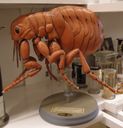Human Flea
Pulex irritans
Classification
- Phylum: Arthropoda
- Subphylum: Hexapoda
- Class: Insecta
- Order: Siphonaptera
- Family: Pulicidae
- Genus: Pulex
- Species: irritans
Pronunciation
How to pronounce Pulex irritans: /ˈpuː.lɛks ˈɪr.ɪ.tænz/
These audio files are automatically generated. While they are not always 100% accurate, they are a good starting point.
Images






Summary
Pulex irritans, known as the human flea, is a cosmopolitan ectoparasite originally from South America, known for infesting humans and a wide array of mammals. It has a complex lifecycle and can be a vector for diseases like the plague.
Physical Characteristics
Adults are approximately 1.5 to 4 mm in length, laterally flattened, dark brown in color, and lack wings. They have piercing-sucking mouthparts and a rounded head without genal or pronotal combs. Flea eggs are about 0.5 mm long, oval, and pearly white. Larvae measure roughly 0.6 mm, are creamy white or yellow, and have 13 segments with bristles. Pupae are about 4 x 2 mm.
Identification Tips
Look for adults that are dark brown, flattened, and lack wings. Adult fleas are often found on hosts and their bites result in itchy welts, frequently in clusters.
Habitat
Commonly found on the bodies of various mammalian hosts, including domesticated pets and wild animals. Larvae live in the environment, feeding on organic debris.
Distribution
Cosmopolitan; originally evolved in Central and South America but spread globally, especially after the 18th century due to fur trade and pet transport.
Diet
Adults feed primarily on the blood of warm-blooded hosts. Larvae consume organic debris in their environment.
Life Cycle
Holometabolous life cycle consisting of four stages: egg, larva, pupa, and adult. Eggs hatch in 3-4 days, larvae complete their development in about 3-4 weeks, and adults emerge seeking a host.
Reproduction
Females lay eggs on the host or in the environment; eggs drop off and develop into larvae, which feed on organic materials before forming pupae.
Ecosystem Role
As ectoparasites, they play a role in the food web as prey for various predators, though they are primarily known for their parasitic relationship with mammals.
Economic Impact
Considered a pest in domestic environments, causing discomfort in hosts and potentially leading to economic losses in pet care and veterinary expenses.
Cultural Significance
Historically associated with disease spread, particularly plague, which had significant impacts on human populations.
Health Concerns
Can transmit the bacterium Yersinia pestis, the cause of plague. Also serves as an intermediate host for the flea tapeworm Dipylidium caninum.
Collecting Methods
- Vacuuming infested areas
- Using trapping devices for fleas
Preservation Methods
- Freezing specimens
- Ethanol preservation
Evolution
Evolved with a specific host in South America but adapted to a wide variety of warm-blooded hosts.
Similar Taxa
- Ctenocephalides felis (cat flea)
- Ctenocephalides canis (dog flea)
- Xenopsylla cheopis (oriental rat flea)
Misconceptions
Often thought to only infest domestic pets, but are actually found on a wide variety of mammals and birds.
Tags
- Ectoparasite
- Flea
- Pulex irritans
- Plague vector